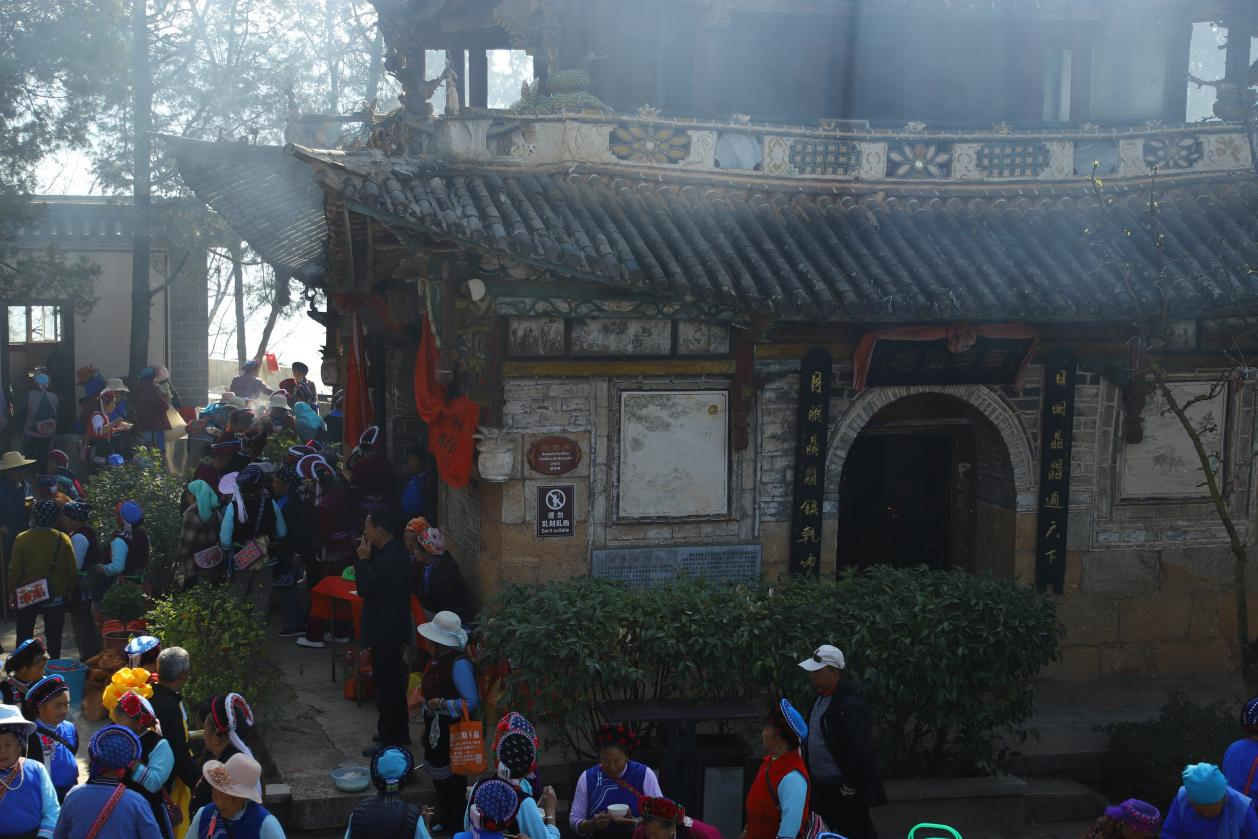Guanyin Pavilion
Li Hao, a scholar from the Ming Dynasty, recorded in his work "Three Yi Essays": "In Hexi, there is a water monster, golden-yellow in color and ox-like in shape. It often transforms into a man to seduce women, causing much suffering. One day, a beautiful young woman arrived, claiming she could eliminate the monster. She went to Erhai Lake and lured the monster out. When the monster saw the woman, it wanted to seduce her. The woman offered it delicious food, saying, 'It's better to eat first and then play.' The monster believed her and ate the food, finding it extremely delicious. The woman then offered a fried dish, shaped like an eel, with a strange aroma. As soon as it was eaten, it moved, its tail like a hook, piercing the monster's nose like a hook, causing it to feel sick and vomit. The vomit landed on the ground and turned into a pile of gold chains, binding its nose. The woman cast a spell, revealing the monster's true form as a golden ox, and chained the golden ox to a rock pillar in the heart of the sea. From then on, the monster ceased its evil deeds. It is said that the woman was actually the incarnation of Guanyin Bodhisattva. During the early years of the Zhao Dynasty, the Meng family built a Guanyin Temple southeast of Luoquan Temple. Inside, Guanyin was sculpted as a young woman, carrying a fish basket, with a golden ox lying beside her, and surging waves surrounding them. This is known as the "Subduing Demon Fish Basket Bodhisattva."
Keyword:
Dali Luoquan
Luoquan Peninsula
Luoquan Pagoda
Tianjing Pavilion
Category:
Spot Description
According to Li Hao's "Three Yis Essays" from the Ming Dynasty, "There is a water monster in Hexi, golden yellow in color and ox-like. It often transforms into a man to seduce women, causing much suffering. One day, a beautiful girl came and said she wanted to eliminate the water monster. The girl led the monster out to Erhai Lake. When the monster saw the girl, it wanted to seduce her. The girl offered it delicious food, saying, 'It's better to eat first and then play.' The monster believed her and ate the food, finding it extremely delicious. The girl then offered a fried dish, shaped like an eel, with a strange aroma. As soon as it was eaten, it moved, its tail like a hook, piercing the monster's nose like a hook, causing it to feel sick and vomit. The vomit landed and turned into a pile of gold chains, which bound its nose. The girl cast a spell, revealing the monster's true form as a golden ox, and tied the golden ox to a rock pillar in the sea. From then on, the monster ceased its evil deeds. It is said that the girl was the incarnation of Guanyin Bodhisattva. At the beginning of the Zhao Dynasty, the Meng family built a Guanyin Temple southeast of Luoquan Temple. Inside, Guanyin is sculpted as a young girl, carrying a fish basket, with a golden ox lying beside her, and the waves surging. It is known as the "Subduing Demon Fish Basket Bodhisattva."
The "Record of the Reconstruction of Luoquan Temple and the Restoration of its Permanent Residence" from the 28th year of the reign of Emperor Kangxi of the Qing Dynasty mentions that the temple was founded during the Jianzhong era (the reign title of Emperor Dezong of Tang, 780-783 AD). Later, "monks rebuilt a pagoda on the mountaintop and built a Great Bodhisattva Pavilion on the cliff."
While the construction of the Guanyin Temple next to Luoquan Temple by the Nanzhao king is not mentioned in official historical records but in Ming Dynasty notes, which may not be reliable, the "Fish Basket Guanyin" is indeed mentioned in Buddhist scriptures. Legend has it that during the Yuanhe era of the Tang Dynasty, there was a fish seller in Shaanxi who carried a basket to sell fish every day. Because of her beauty, many people proposed marriage to her. The fish seller said that she would marry the one who could recite the "Guanyin Universal Door Chapter" in one night. In the end, only the son of the Ma family could recite it, so the fish seller kept her promise and married into the Ma family. However, on the wedding day, before the guests had left, the fish seller died suddenly and had to be buried outside the city on the Jinsha Beach. Several days later, an old monk came with a staff and opened the grave to examine the body. There was no body, only a set of golden chainmail bones. The old monk told everyone that this was the incarnation of Guanyin Bodhisattva to teach people. Then, he used his staff to lift the bones into the air and flew away. From then on, the number of people who believed in Buddhism increased greatly. This is the legend of "Fish Basket Guanyin." "Fish Basket Guanyin" is also known as "Fish Basket Great Bodhisattva" and "Ma Langfu Guanyin," one of the incarnations of Guanyin Bodhisattva, in the form of a young girl. "Yuanhe" is the reign title of Emperor Xianzong of Tang, lasting 15 years, from 806 to 820 AD. Before that, there were the Zhenyuan (785-805), Xingyuan (784), and Jianzhong (780-783) eras, more than 20 years apart from Jianzhong. The "Alliance at Cangshan Mountain" between Nanzhao and the Tang Dynasty took place in 794 AD (the 10th year of Zhenyuan in the Tang Dynasty). During the Jianzhong era, Nanzhao had not yet submitted to the Tang Dynasty and was still under the rule of Tubo. Regarding the introduction of Buddhism into the Dali region, the academic community generally believes that there were three routes: one from Tianzhu via Tubo to Nanzhao, two from India and Myanmar via the "Shu Shen Du Dao," and three from the Central Plains. After the Tang Tianbao War (751-754 AD), during the more than 40 years until the 10th year of Zhenyuan (794 AD), the Nanzhao king was enfeoffed by Tubo as "Zanpu Zhong," titled "Eastern Emperor," and granted the status of a brotherly nation, maintaining close relations. Before that, Tubo forces had already reached the Erhai Lake area. It goes without saying that Guanyin culture, as a part of Esoteric Buddhism, was introduced from Tubo. It is also self-evident that after Nanzhao submitted to the Tang Dynasty in 794 AD, it was influenced by the culture of the Central Plains. Therefore, it seems unreliable that the "Guanyin Temple" or "Great Bodhisattva Pavilion" next to Luoquan Temple was built at the "beginning of the Zhao Dynasty," but it is possible that it was built after the Tang Jianzhong era. In other words, the construction of the Guanyin Pavilion during the Nanzhao period has historical evidence. Relevant historical materials also state that during the period of Quan Fengyou of Nanzhao (824-859 AD), many temples and pagodas were built, and some famous temples such as Chongsheng Temple, Gantong Temple, and Bianzhi Temple in Fengyi were all built during this period.
Whether the Guanyin Temple or Great Bodhisattva Pavilion is the same as the later Guanyin Pavilion remains uncertain. However, based on the above information, we can confirm that a Guanyin Pavilion (Great Bodhisattva Pavilion) was built next to Luoquan Temple during the Nanzhao Kingdom.
Regarding the current Guanyin Pavilion, a "Record of the Origins and Events of the Guanyin Pavilion," written around the Tongzhi era of the Qing Dynasty, states: "It was founded in the fourth year of Tianfu during the Jin Dynasty. Local people built the pavilion because of the strong winds and huge waves in Erhai Lake, which often damaged boats, and because of the popular belief in Guanyin Bodhisattva's ability to save people from danger. ... During the 15th year of Hongwu, Generals Fu and Mu pacified Yunnan, and they received guidance from Guanyin. After the pacification of Yunnan, General Mu stationed there and carried out major repairs to the Guanyin Pavilion, building two corridors as monks' quarters and a multi-story building as the Tianjing Pavilion. ... Later, it was slightly damaged and was repaired by a kind person who donated all his property, restoring it to its former glory. Two elderly people from the village of Zhuang were in danger at sea and called out for help, and they were miraculously saved. They donated 22 hectares of land for the temple's upkeep. This happened in the 48th year of Wanli. ... In the 49th year of Kangxi, Shao Duokui, a student from the Lijang Prefecture Academy, led the gentry and kind people from the Ta Village to repair the pavilion, with the support of the prefect Zhang Gong, who initiated donations. ... They worked hard to repair it, making it a famous scenic spot. ... Unexpectedly, in the autumn of Bingchen, the pavilion was destroyed by war."
The "Jin" mentioned here refers to the Later Jin Dynasty during the Five Dynasties and Ten Kingdoms period. The fourth year of Tianfu was 939 AD. Duan Siping ascended the throne in 937 AD (the second year of Tianfu in the Later Jin Dynasty). The fact that it was founded in the fourth year of Tianfu indicates that the Guanyin Pavilion was built two years after the establishment of the Dali Kingdom. According to this, the Guanyin Pavilion was built in the early days of the Dali Kingdom, and it has a history of more than a thousand years.
From the "Record of the Origins and Events of the Guanyin Pavilion," we can see that throughout the Song, Yuan, Ming, and Qing dynasties, the Guanyin Pavilion underwent several changes and was repaired many times, experiencing periods of prosperity and decline, until it was destroyed by war in 1856 (Bingchen year of Xianfeng in the Qing Dynasty).
Later, the Guanyin Pavilion, which had been destroyed by war, was repaired, as evidenced by the "Appeal for Donations for the Reconstruction of the Guanyin Pavilion," which was written around the same time as the "Record of the Origins and Events of the Guanyin Pavilion." However, in 1950, Jiahai, a nun who had recently become a caretaker, accidentally started a fire, and the Guanyin Pavilion was once again reduced to ashes.
The current Guanyin Pavilion was repaired by local villagers in 1981. It is said that a rural woman from Xiangyang Wenbi Village, not far from here, was unconscious for seven days and seven nights. After being put into a coffin, she woke up. The first thing she said after waking up was that the heavens had instructed her to rebuild the Guanyin Pavilion. Under her leadership, people raised funds and finally rebuilt the Guanyin Pavilion.
The newly built Guanyin Pavilion was slightly moved inland due to damage to the original cliff face caused by quarrying. The pavilion has two floors. The lower floor has doors on all four sides, with a central passage allowing passage in all directions. The upper floor has a surrounding corridor, and the four corners of the eaves have copper bells that chime pleasantly in the wind, evoking the atmosphere of an ancient temple. A Guanyin statue is enshrined in the center of the upper floor. Its unique design is both serene and dignified, representing the traditional image of Guanyin in the Dali region. Two other statues, resembling Guanyin, flank the central statue. Legend says that these three statues are known as the "Three Guanyin Sisters," with the central one being Miaoshan, and the others being Miaoyuan and Miaoyin. To facilitate access for visitors and pilgrims, stairs have been added, and the east and south entrances on the lower floor have been sealed. A painting of "Guanyin with Fish Basket Subduing Demons" hangs in the center of the sealed south entrance. The painting depicts Guanyin as a young woman carrying a fish basket, with a golden ox lying beside her. The pavilion's overall design reflects the traditional style of Bai folk architecture, making it extremely beautiful and elegant. Chen Congzhou (1918-2000), a professor at Tongji University, environmental and landscape art consultant for I.M. Pei's architectural design firm, foreign academician of the Japan Academy, and member of the Shanghai Municipal Cultural Relics Management Committee, included a photograph of its design in his "Chinese Garden Appreciation Dictionary" as a beautiful example of ethnic architecture.
The original Guanyin Pavilion, which was reduced to ashes over 50 years ago, is described in the Republican-era "Haidong Zhi" under the entry "Guanyin Pavilion" as being "located on the headland of an island in the sea, half a li from Luoquan Temple, and the main hall of Tianjing Pavilion." "Island" refers to the Luoquan Peninsula, as peninsulas and islands were often referred to as islands in ancient times, hence the frequent reference to "Luoquan Island" or sometimes "Luoquan Mountain." "Headland" indicates that the Guanyin Pavilion was built on the seaward tip of the peninsula. "Main hall of Tianjing Pavilion" is because the Guanyin Pavilion and Tianjing Pavilion were "combined into one temple," sharing the same grounds. The "Appeal for Funds to Rebuild the Guanyin Pavilion" states that "the pavilion stands facing the west side of Erhai Lake, at the foot of Luoquan Mountain, as the rear palace of Tianjing Pavilion." Referred to as both "main hall of Tianjing Pavilion" and "rear palace of Tianjing Pavilion," it is clear that Tianjing Pavilion faced the sea, while Guanyin Pavilion was situated behind it on the mountain, one facing the sea and the other the mountain, within the same complex. Before the coastal cliff was damaged, the two pavilions commanded a strategic position overlooking both sea and mountain, and their grandeur is easy to imagine. Unfortunately, this cannot be restored. It would be difficult to place the newly built 25.4-meter-high, five-story Tianjing Pavilion in front of the newly restored Guanyin Pavilion. Therefore, only a small Taizi Pavilion was built on the site of the original Tianjing Pavilion.
After Buddhism was introduced to China, it gradually became Sinicized, and Guanyin became the most popular deity among the Chinese people. In the Dali Bai region, the worship of Guanyin is even more prominent. It's not an exaggeration to say that "every family chants Amitabha, and every household has Guanyin." Guanyin is the first Bodhisattva worshipped by the people. Some even only know Guanyin Bodhisattva but not the Buddha Shakyamuni. The worship of Guanyin may originate from the Lotus Sutra and related Buddhist legends. The Lotus Sutra describes Guanyin as a Bodhisattva of great compassion, who, when people are in distress, will come to their rescue upon hearing their invocation. It is said that Guanyin, in order to save all beings from suffering, will manifest various incarnations, with the "thirty-three manifestations." Guanyin, with boundless power and dedicated to saving suffering beings, is indeed the most virtuous and beautiful Bodhisattva in the minds of people in this world full of suffering, a lucky star that can comfort and even encourage those who have suffered misfortune. The Bai people are a people who are easily able to absorb foreign cultures and integrate them into their own beliefs. The worship of Guanyin in Dali is both widespread and unique, with local legends and sites of Guanyin everywhere. For example, the people of the Dali Basin were pacified after Guanyin used her magical powers to subdue a demon that ate people's eyeballs; the Nanzhao and Dali kingdoms were established through Guanyin's guidance; even the pacification of Yunnan by Fu Youde and Mu Ying in the fifteenth year of the Hongwu reign of the Ming Dynasty was attributed to Guanyin's guidance. There are even more legends of Guanyin saving people from suffering. The Guanyin Pavilion was built because of Guanyin's "compassionate rescue," Mu Gong's major repair of the Guanyin Pavilion was because of "Guanyin's guidance," and the Jinsuo Island opposite the Guanyin Pavilion was brought by Guanyin to fill the sea... Due to historical accumulation, unique geographical location, and the wonders of mountains and waters, the Guanyin Pavilion, located on the Luoquan Peninsula of Xiangbinling, Haidong Yu'an Mountain, in the south of Erhai Lake, has naturally become a well-known Guanyin site. It is said that Guanyin originally practiced in Nanshan Putuo Mountain, and later, places where Guanyin appeared were often called "Putuo." "Putuo" is a transliteration of Sanskrit, originally meaning "beautiful little white flower." The most famous Putuo Mountain in China is in Zhejiang. It is said that there is a place where Guanyin appeared, a beautiful island known as the "Sea and Sky Buddhist Kingdom." The Guanyin Pavilion here is also known as "Nanshan Putuo." "Erhai Lake and Cangshan Mountain, the Qilu of Buddhism." The poem by Wu Weiye of the early Qing Dynasty is very apt, the center of the Miaoxiang Buddhist Kingdom, Cangshan Erhai Lake, is full of temples, and there are many temples with Guanyin as the main Buddha. For example, Chongsheng Temple, it is said that it originally had Guanyin as the main Buddha, "sheng" means "holy Guanyin," Chongsheng means worshiping holy Guanyin. Guanyintang is even more needless to say, it was built because of the victory of Guanyin blocking the soldiers with stones. There is also Wase Haiyin Wenji Island, which also has a Guanyin Pavilion built on it. The 100-square-meter Wenji Island is said to be the great seal of Guanyin镇海, and is now commonly known as "Little Putuo." But the most imposing "Sea and Sky Buddhist Kingdom" is still the Guanyin Pavilion here. The history of this Guanyin Pavilion is longer than that of Wenji Island (Haiyin) Guanyin Pavilion. Because the pavilion is located at the southern end of Erhai Lake, and there are many stories of compassionate rescue and inspiration, it has long been the "Nanshan Putuo" in the hearts of believers. It is said that the Guanyin here is extremely effective, "those who call out to the pavilion from afar for help will receive peace, and the miraculous events are too numerous to count." The Guanyin divination slips in front of Guanyin are different from those of any other Guanyin. Those who draw lots are always amazed. In addition to those who come to worship and sightsee, there are also many pilgrims who come to fulfill their vows, some even traveling thousands of miles to do so. In 1998, a group of pilgrims from Hong Kong came to Dali "Nanshan Putuo" to fulfill their vows, donating a considerable amount of merit but insisting on remaining anonymous. Because of the fame of the Guanyin Pavilion, even before the Tianjing Pavilion was repaired, people only knew the Guanyin Pavilion. Even after the Tianjing Pavilion was repaired, and the scenic area was officially named Tianjing Pavilion, many people still call it the Guanyin Pavilion scenic area.
The Guanyin Pavilion and Tianjing Pavilion were originally part of the same temple complex. Although now somewhat distant, they still belong to the same scenic area. The two pavilions complement each other, attracting domestic and foreign tourists with their beautiful scenery and unique Bai Buddhist esoteric Guanyin culture. Dali's Nanshan Putuo offers convenience and spiritual experiences for visitors and pilgrims from far and wide.
Ascend Tianjing Pavilion, enter a fairyland, transcend the mundane;
Worship Guanyin, forge a Buddhist connection, pray for blessings and ward off disasters.
Recommended Attractions
Wind, Flower, Snow, Moon Pavilion
The First Pavilion of Erhai Lake - Tianjing Pavilion









